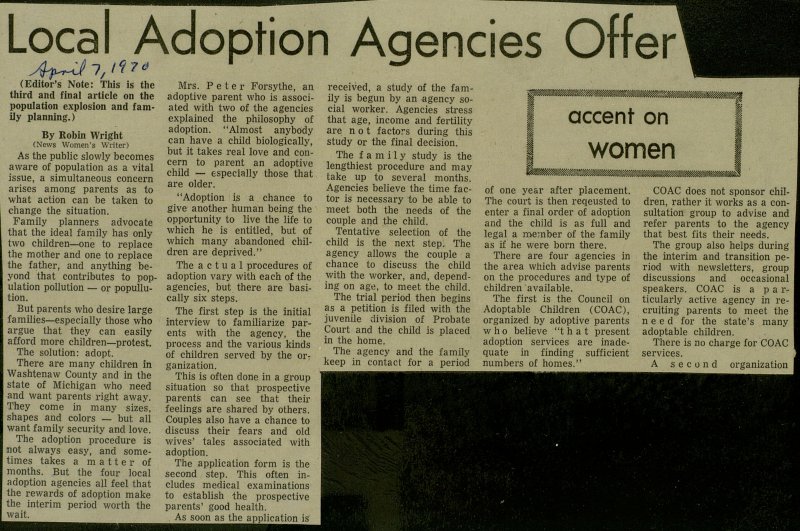Local Adoption Agencies Offer Alternative To 'Popullution'


(Editor's Note: This is the third and final article on the population explosion and family planning.) By Robin Wright (News Women's Writer) As the public slowly becomes aware of population as a vital issue, a simultaneous concern arises among parents as to what action can be taken to change the situation. Family planners advocate that the ideal family has only two children - one to replace the mother and one to replace the father, and anything beyond that contributes to population pollution - or popullution. But parents who desire large families - especially those who argüe that they can easily afford more children- protest. The solution: adopt. There are many children in Washtenaw County and in the state of Michigan who need and want parents right away. They come in many sizes, shapes and colors - but all want family security and love. The adoption procedure is mot always easy, and sometimes takes a matter of months. But the four local adoption agencies all feel that the rewards of adoption make the interim period worth the wait. Mrs. Peter Forsythe, an adoptive parent who is associated with two of the agencies explained the philosophy of adoption. "Almost anybody can have a child biologically, but it takes real love and concern to parent an adoptive child - especially those that are older. "Adoption is a chance to give another human being the opportunity to live the life to which he is entitled, but of which many abandoned children are deprived." The actual procedures of adoption vary with each of the agencies, but there are basically six steps. The first step is the initial interview to familiarize parents with the agency, the process and the various kinds of children served by the organization. This is often done in a group situation so that prospective parents can see that their feelings are shared by others. Couples also have a chance to discuss their fears and old wives' tales associated with adoption. The application form is the second step. This often includes medical examinations to establish the prospective parents' good health. As soon as the application is received, a study of the family is begun by an agency social worker. Agencies stress that age, income and fertilily are n o t factors during this study or the final decisión. The family study is the lengthiest procedure and may take up to several months. Agencies believe the time factor is necessary to be able to meet both the needs of the couple and the child. Tentative selection of the child is the next step. The agency allows the couple a chance to discuss the child with the worker, and, depending on age, to meet the child. The trial period then begins as a petition is filed with the juvenile división of Probate Court and the child is placed in the home. The agency and the family keep in contact for a period of one year after placement. The court is then reqeusted to enter a final order of adoption and the child is as full and legal a member of the family as if he were born there. There are four agencies in the área which advise parents on the procedures and type of children'available. The first is the Council on Adoptable Children (COAC), organized by adoptive parents w h o believe "t h a t present adoption services are inadequate in finding sufficient numbers of homes." COAC does not sponsor children, rather it works as a consultation group to advise and refer parents to the agency that best fits their needs. The group also helps during the interim and transition period with newsletters, group discussions and occasional speakers. COAC is a particularly active agency in recruiting parents to meet the need for the state's many adoptable children. There is no charge for COAC services. A second organization formed by a group of concerned citizens is the Spaulding For Children Agency for hard-to-place children. Formed in 1968 and.maintained through contributions, the group is dedicated to finding homes for unplaced children who need special services and intensive efforts if they are ever to have families of their own. The children's limitations involve age, physical handicaps or a disadvantaged background. Spaulding also maintains no direct child intake service pJÉ its own. The agency serves children referred by other agencies unable to find permanent families for them. There is no charge for adoptive parents. The Catholic Social Service (CSS) organization is mainly responsible for placing newborns since it offers complete counseling for pregnant women throughout and after pregnancy. Although a Catholic agency, families of all denominations are served. Children are placed in homes of the relgous beliefs as specified by the natural mother. CSS also prefers to place at least two children with a qualified family. And if a family does not qualify after a study is made, CSS offers counseling service so that parents may work out the problem and qualify for a child. The agency is supported by United Fund, so there is only a minimum $100 charge to have the home study made. Donations beyond that are welcome. The Michigan Children's Aid Society (MCAS) is the fourth agency serving prospective parents of adoptive children. MCAS also places a majority of very young children, although it does work with soms older children. The maximum fee is $350, although the rate is based on a sliding scale and no family s turned away for financial reasons. A non-sectarian agency, MCAS, like the other three' services, stresses the main qualification for adoption as the ability to help a child just by providing a comfortable and loving home.